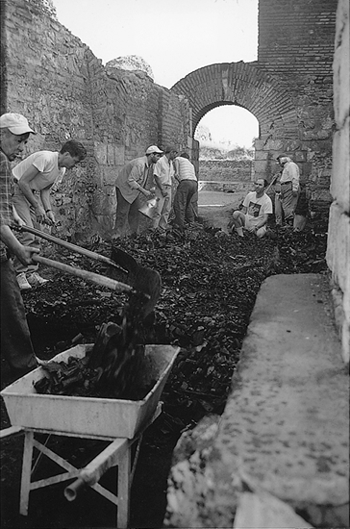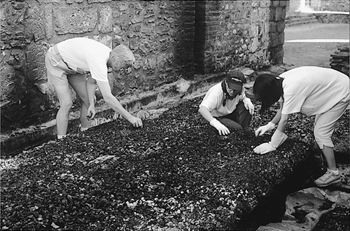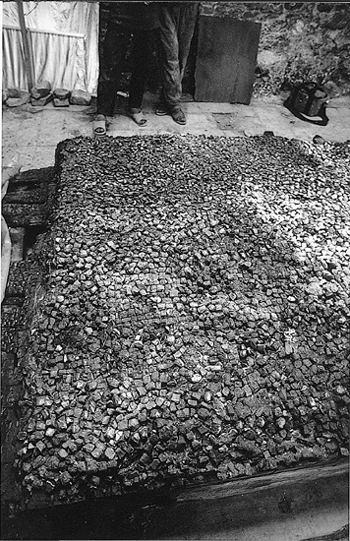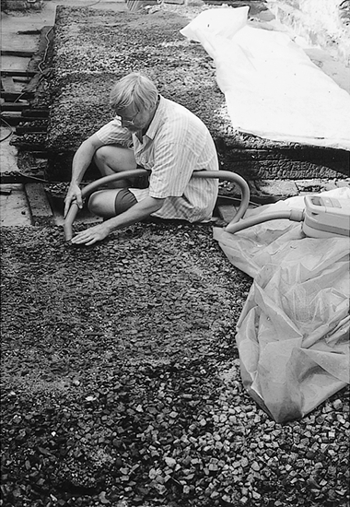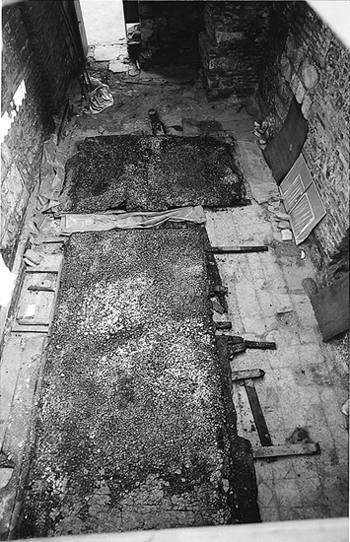RECOVERY OF UNBACKED MOSAICS FROM A STORAGE DEPOT FIRE AT THE SARDIS EXCAVATIONS, TURKEYKENT SEVERSON, STEPHEN KOOB, JULIE WOLFE, PERRY CHOE, STEPHANIE HORNBECK, SARAH MCGREGOR HOWARTH, & ANTHONY SIGEL
3 3. INITIAL RECOVERYRemoval of the large smoldering beams required a certain amount of walking on the debris and on surfaces where mosaics were known to have been stored underneath. Other materials stored in the depot included rush mats and synthetic resin roofing panels from the new roof under construction over a nearby excavation. Although these combustible materials were removed from around the mosaics while still smoking, they did not appear to contribute significantly to the impact of the fire on the mosaics. Workers began to clear the room by shoveling the debris and shattered tiles into wheelbarrows (fig. 6), starting at the ends of the room and working toward the center where the mosaics were stacked. In spite of efforts to minimize foot traffic on top of the mosaics, occasional steps on the burned platforms were unavoidable during the initial clearing operations. It was feared that water used in putting out the fire had softened the adhesive used in facing, so as soon as possible, all foot traffic was directed away from the stacks to avoid further disruption of the tesserae. As paths around the mosaics were opened, conservation staff and volunteer archaeologists began to pick pieces of roof tiles off the surface of the mosaics by hand (fig. 7). Picking continued until the first layers of charred tesserae began to appear.
With the perimeter of the platforms and the bulk of the debris cleared, a preliminary assessment of the condition of the mosaics was made. The heat of the fire and combustion of facing materials left the facing and interleaving materials in the uppermost layers of the stacks completely destroyed. The blackened tesserae of the top layers were mixed with the layers beneath and with tesserae-sized fragments of roof tiles and charcoal. It was clear from the beginning that any effort to brush the surface of the stacks to remove debris would disturb what little order remained in the loose tesserae. Sadly, the small tesserae used in the inscription, stored at the top of the main stack, appeared to be randomly mixed with the larger tesserae beneath. Fire had penetrated beneath the platform at the south end of the depot, resulting in partial collapse at the end of the stack and at the west side nearby. In this area the mosaics were slumped into a resultant void in a jumble of mixed tesserae. Around the edges, the facing and plastic interleaving were completely charred, and tesserae were slumping toward the outside of the stacks. The disorderly slumping of tesserae suggested that some of these areas were irretrievably lost. Nonetheless, some order to the tesserae seemed to survive in many areas (fig. 8). A little probing around the edges of the stacks showed that beneath the first one or two layers, the cloth facing seemed to be intact, giving hope that at least some of the mosaics could be recovered.
Various methods were tested for removing finer debris from between the tesserae, including forced air from squeeze bulbs and an agricultural sprayer, but these only disturbed the tesserae further. In the end, a vacuum cleaner fitted with a screen over the nozzle was used to lift the charcoal fragments and smaller roof tile fragments from the damaged surfaces (fig. 9). After several weeks of vacuuming, the mosaics were left to completely dry out (fig. 10). At about the same time, a new steel roof was constructed over the depot.
|
